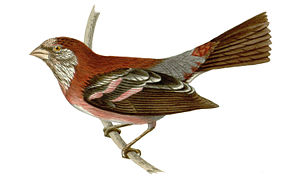Bindengimpel
| Bindengimpel | ||||||||||||
|---|---|---|---|---|---|---|---|---|---|---|---|---|

Bindengimpel ( Carpodacus trifasciatus ) |
||||||||||||
| Systematics | ||||||||||||
|
||||||||||||
| Scientific name | ||||||||||||
| Carpodacus trifasciatus | ||||||||||||
| Verreaux , 1871 |
The blackfinch ( Carpodacus trifasciatus ) is a songbird from the finch family . The southeast Palearctic species occurs in western and southern China .
description
The binding Gimpel is 17 to 19.5 cm of length slightly greater than a Kernbeißer . Due to its wing markings and other characteristics, it can hardly be confused with other species of carmigimpel . The 15–16 mm long beak is strong with a broad, deep-set base. The upper beak is dark horn-colored, the lower beak yellowish-green or yellowish horn-colored. The feet are dark brown. The wing length is between 82 and 88 mm, the tail length between 71 and 72 mm.
The sexes differ significantly in the color of the plumage. The male's forehead is white. The crown, the back of the head and the sides of the neck, like the back and the inner shoulder feathers, are strong to dark carmine red with black feather bases. There are also often dark feather centers or gray hems on the back. The reins, eye stripes and ear covers are blackish with red borders and white shaft stripes. The chin and throat are black with beige shaft stripes in the fresh plumage. The front breast is dark wine red with black feather bases. The chest and flanks are carmine or wine red, the sides of the chest gray. The belly and rear flanks, like the under tail-coverts, are white. The latter also have gray feather centers and black shaft stripes. The outer shoulder feathers are whitish and form a light band over the closed wing. The arm covers are blackish with light pink tips. Alula , coverts and wings are black. The umbrella springs show a wide, white field at the tip of the outer flag. The lower back is carmine to rose red. The upper tail covers also have gray tips. The angular tail is black.
The female is dark gray with black stripes on the top of the head, neck, back and shoulders. The outer shoulder feathers are yellowish beige or whitish. The face is warm brownish with gray or blackish spots. The chin and throat are yellowish brown. The chest and flanks are warm brown or yellowish in tint, the lower chest and sides are beige, the belly and the underside of the tail are gray-beige. The rump is pale brown or olive brown, the upper tail-coverts black-brown, the tail black. The wing feathers are similar to those of the male, but the arm covers are rather dark gray with pale hems and have yellowish beige to orange yellow tips. The field at the end of the outer flags of the shield springs is white or yellow-white. The female's beak is a bit slimmer than that of the male and a bit lighter and more monochrome.
The youth dress is similar to that of the female. Males in the first winter show slightly yellowish outer shoulder feathers, the tips of the umbrella feathers are orange-yellow. The large arm covers have yellow tips and the rump is warm reddish brown. The face is more like that of the adult male with long white tips. The face, chest and flanks are reddish brown than in the female. The beak is like the female, but already shows yellow at the base.
The species is relatively sluggish and moves slowly. The bird often sits motionless in the vegetation for a long time. The Bindengimpel is not very vocal. Nothing is known about the singing.
distribution
The monotypical penguin colonizes southwest Gansu to western and southern Sichuan . He was also found during the breeding season in the Yulong Xueshan near Lijiang in northwestern Yunnan . The penguin is usually rare or occurs scattered. But it is not threatened.
Way of life
The Bindengimpel lives at altitudes between 2130 and 3050 m above sea level. In late autumn or winter, some populations migrate to lower altitudes up to around 1800 m, others move in a south-westerly direction to overwinter along the Tsangpo in southeastern Tibet. They will return from mid-March.
The species breeds in undergrowth and thickets within sparse coniferous forests. In winter they can be found in orchards, hedges, dwarf medlars , wild apple bushes and in fields. The food consists of seeds and is collected on the ground or in bushes. Nothing is known about the breeding biology.
literature
- P. Clement, A. Harris, J. Davis: Finches and Sparrows. Helm Identification Guides, London 1993/1999, ISBN 0-7136-5203-9 .
- J. Martens, S. Trautmann: Carpodacus trifasciatus. in Atlas of the Distribution of Palaearctic Birds , Delivery 21, 2008, ISBN 978-3-9807089-2-0 .
Web links
- Carpodacus trifasciatus in the endangered Red List species the IUCN 2009. Posted by: BirdLife International, 2009. Accessed on March 20 of 2010.
- Videos, photos and sound recordings of Carpodacus trifasciatus in the Internet Bird Collection
- Photos of Carpodacus trifasciatus in the Oriental Bird Club image database , accessed March 20, 2010